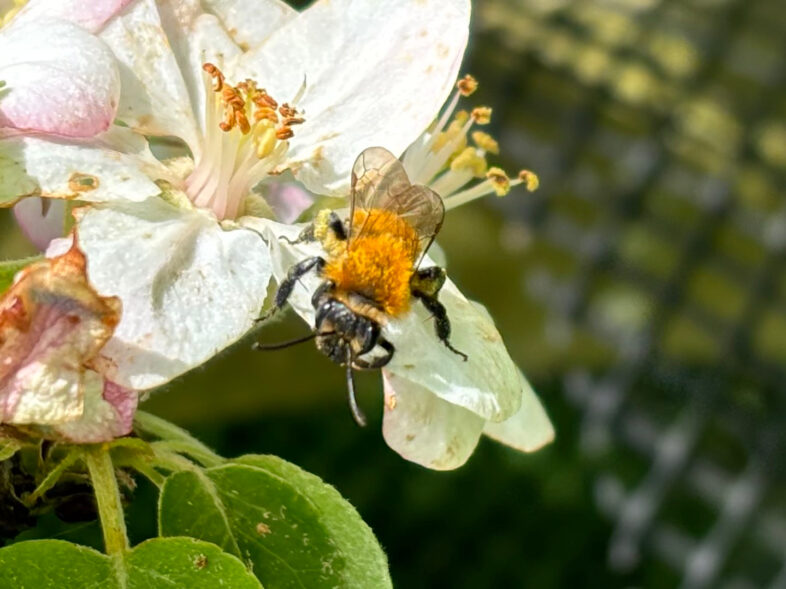
Milwaukee Mining Bee by Juno Stahl
With more than 350 species of wild bees in Vermont, it’s daunting to understand them all. So let’s start with a beloved flowering tree that is all over Vermont’s commercial farms, homesteads, and private properties alike: apple trees!
The domesticated Western Honey Bee (Apis melifera) gets credit for most of the agricultural pollination in North America, but in many cases, wild bee species are more effective pollinators. And unlike the Honey Bees in the northeast, wild bees do not need human assistance to survive—just a safe place to nest and plenty of flowers to eat from. By identifying and understanding the natural history of these bees, you can provide their habitat and help ensure resilient and abundant pollination services and the tasty treats that result.
What You Should Know About Apple Pollination
Many apple cultivars are self-incompatible, and need pollen from a different variety of apple tree nearby to produce fruit. And the presence of wild bees has been shown to increase honey bee movement between trees, increasing the chance of cross pollination.
Apple bloom time varies depending on the cultivar, but generally apples flower at a time in the spring when there are diverse and abundant wild insect pollinators for pollination. In many orchards where wild pollinators are sufficiently abundant, managed honey bees may not be required for commercial yield and fruit quality. Emerging research even suggests nocturnal pollinators, like moths, play an important synergistic role alongside bees in apple pollination.
How to Support Pollinators in Your Apple Orchard
Provide flowers, especially native ones for as much of the growing season as possible. Also leave a messy area with leaf litter and dead plant stalks, which provide important nesting and overwintering habitat for many bees. Be careful and conservative with any pesticide applications—avoid spraying during bloom when possible, and follow an integrated pest and pollinator management plan.
Know Your 5 Apple Pollinators
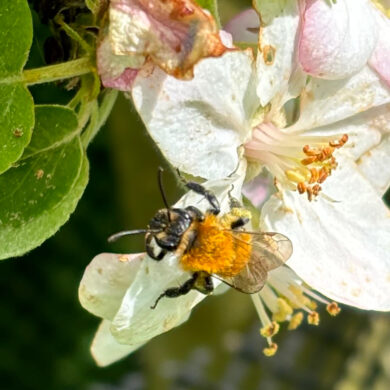
Milwaukee Mining Bee by Juno Stahl
Mining Bees (genus Andrena)
Mining Bees are among the most abundant apple pollinators. At least 12 species have been recorded on apples, with the Hawthorn Miner (Andrena crataegi) being the most common. This species is active from mid-May through June. Adding June blooms such as Blackberries, American Chestnut, Cilantro, and Staghorn Sumac to a farmscape might help increase numbers of this and other species.
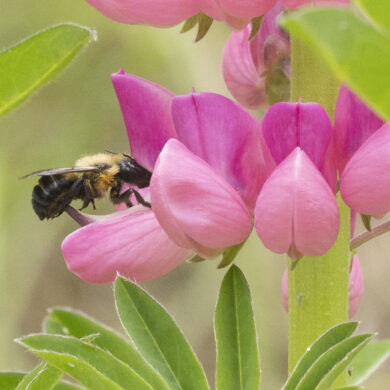
Bufflehead Mason Bee by Michael Foster
Mason Bees (genus Osmia)
These shiny blue bees are efficient pollinators of many spring blooming fruits. The Blue Orchard Bee (Osmia lignaria) is a well known fruit tree pollinator that is active as early as late March. Females can be identified by the pollen (or pollen-collecting hairs) underneath the abdomen. Many species nest above ground in pre-existing cavities, including bee hotels.
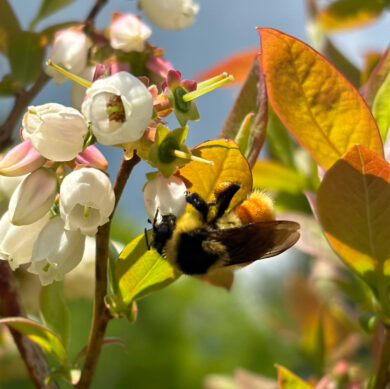
Tricolored Bumble Bee by Juno Stahl
Bumble Bees (genus Bombus)
These large, charismatic bees are great pollinators of most crops. Queens emerge in early spring and do most of the apple pollination. Smaller workers are born in early June. Add early blooming flowers (willows, maples, etc.) and nesting habitat (hedgerows and woodlots) to maximize local populations. There are 13 species in Vermont, many of which can be identified in the field with practice.
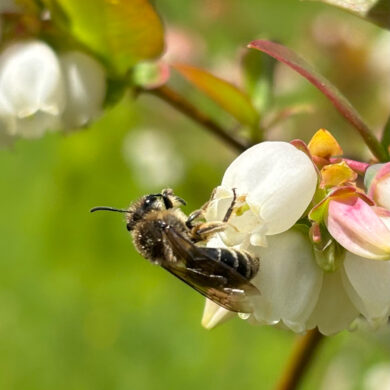
Unequal Cellophane Bee by Juno Stahl
Unequal Cellophane Bee (Colletes inaequalis)
This is one of the first bees to emerge in the spring. Often the first sign is “ant” hills with pea-sized holes, which are the nesting sites of females. Other ground nesting bees make similar nests, but the large aggregations of this species in sandy soil are particularly noticeable. This species is done flying by early June, but is likely an important pollinator of some orchards, especially early-blooming ones near sandy soils.
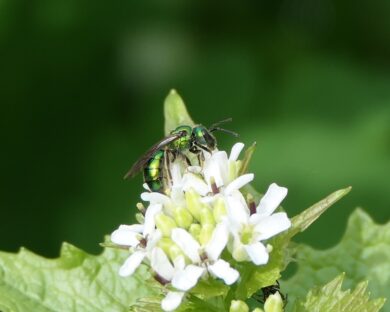
Pure Green Sweat Bee by @neilhusher on iNaturalist
Pure Green Sweat Bee (Augochlora pura)
These brilliant metallic bees are one of several green species that may visit fruit crops. It nests in rotting logs and stumps, and can be abundant in many habitats, especially around heavy or wet soils where ground nesting bees are sparser. Leaving large logs to rot near an orchard is an easy way to attract this and several other log-nesting species.
Know Your 5 is a project of the Vermont Pollinator Working Group, in collaboration with University of Vermont Extension, and with funding from the Gund Institute’s Apis Fund. For more information about bees, email . For questions about pollinator support practices on farms, email .
